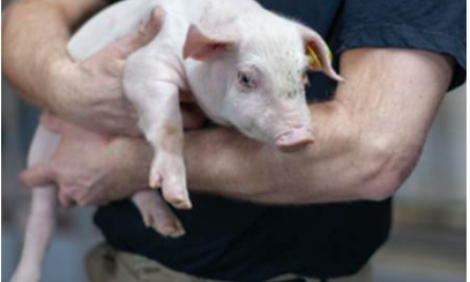



Intestinal Diseases Incur a Heavy Cost
Intestinal diseases have a huge impact on the resources of the pig industry and compromises on enteric health lead to waste and incur a heavy cost, writes ThePigSite editor in chief, Chris Harris.Veterinarian Dr Kent Schwartz said the economic reality is that even a small drop in feed efficiency of around one-tenth of a pound can have a cost effect of $3.50 per pig.
There are also implications for carcass quality and safety with further financial consequences to the producer.
Speaking at the World Pork Expo in a presentation sponsored by Boehringer Ingelheim, he said that most of the pathogens that affect pig performance are with them every day. However, it is not only the bugs that affect performance, but also the environment for the pigs.
He said that in the US, more than 96 per cent of farms are found to have serum antibodies for ileitis and similar enteric disease. The prevalence varies between farms but global surveys have shown a similar situation around the world.
For a disease outbreak to occur, the potential pathogen has to find a conducive environment and a susceptible host.
Dr Schwartz compared the presence of pathogens in pig herds to an iceberg where he said that many of the subclinical problems are hidden under the surface.
The clinical costs of a disease outbreak caused by a pathogen can be seen in the deaths, culls and medication that has to be administered.
He said that the examples of enteric diseases such as salmonella and ileitis have both clinical and subclinical facets but there are also common infections that are very difficult to eliminate from the herd.
Ileitis, in particular, affects growth in the pigs during finishing phase, when the economic impact for the producer is at its greatest.
He said that both salmonella and ileitis are seen in the herd all the time but while salmonella fades as the pig gets older, the incidence of ileitis rises during the pig's life.
"Most of the time, you do not see the two together," Dr Schwartz said.
"But the infection is progressive over time and as no pig is the same, each population has to be assessed."
He said that for a vaccine against a disease such as ileitis to be effective, it has to be administered two to three weeks before the disease appears. Any treatment after an infection takes hold is antimicrobial.
However, for many producers, it is unsustainable to medicate all the time for while some of the costs can be seen and accounted for in the treatment of clinical symptoms, subclinical costs, below the surface can be high.
Mortality, culling and medication costs can be measured precisely but costs such antimicrobial use and the effects on feed efficiency, average daily gain and carcass quality cannot be measured so easily.
Dr Schwartz said that research has shown that the optimum time for vaccination against ileitis is in the mid- to late nursery stage - about six weeks old - and proven protection is three weeks after vaccination. When a pig is infected, the serum antibody is detectable three weeks after infection.
He added that knowing how and when to react to disease is an important element in prevention.
Dr John Kolb from Boehringer Ingelheim showed that clinical trials using Boehringer's own vaccine, Enterisol SC-54, helped to reduce post-harvest Salmonella.
The trial took litters blocked by farrowing date and dam parity and administered randomised treatments seven days before weaning. The test was run as a blind study and the pigs were mixed in the pen at weaning.
It was found found that Salmonella were widespread in the pen as the pigs came near to the time for market, but there were no signs of any disease outbreak and at the time of harvest, 100 pigs were chosen randomly by eartags.
The transport, lairage and abattoir were cleansed to ensure that there was no cross-contamination and post-harvest swabs were taken. Viscera was collected for tests on the lymph nodes and swabs taken from the carcasses following overnight chilling.
The results showed that there was no Salmonella on the animals that had been vaccinated and overall, there was a significant drop in the number of positive tests for Salmonella.
Dr Kolb said it showed that vaccination can be a viable safety tool for pork.
Further Reading
| |
- | Find out more information on ileitis by clicking here. |
July 2011









